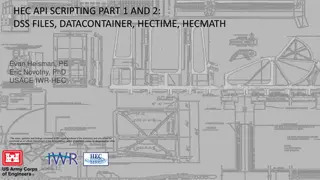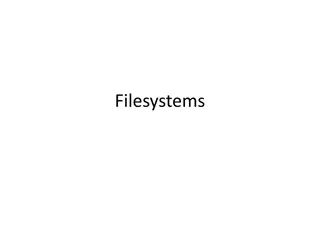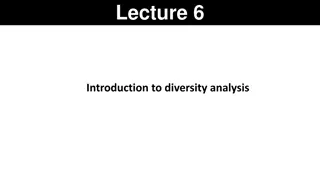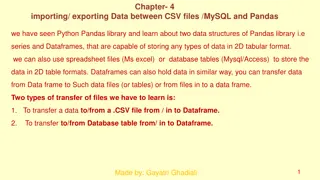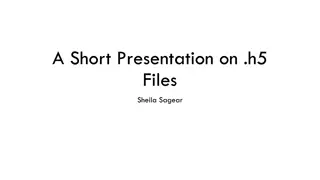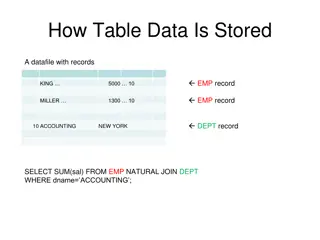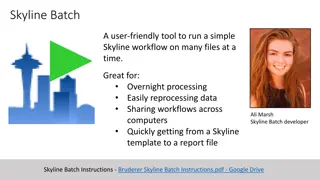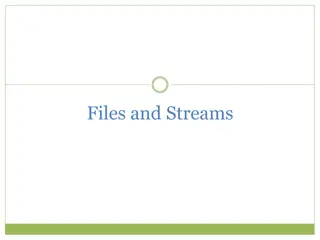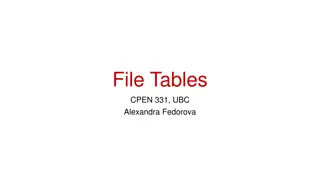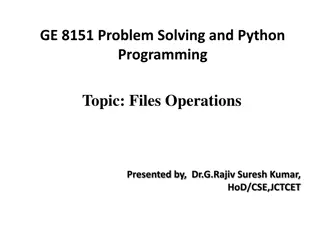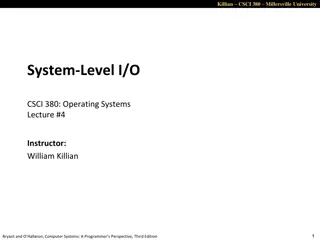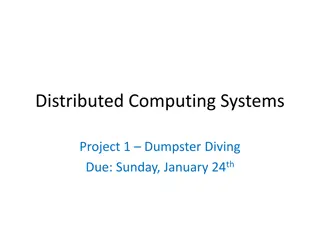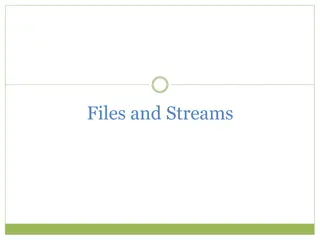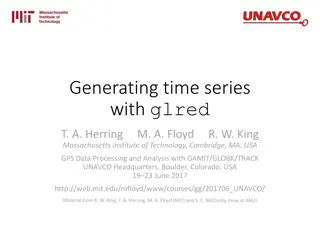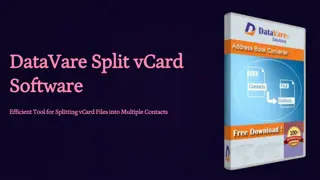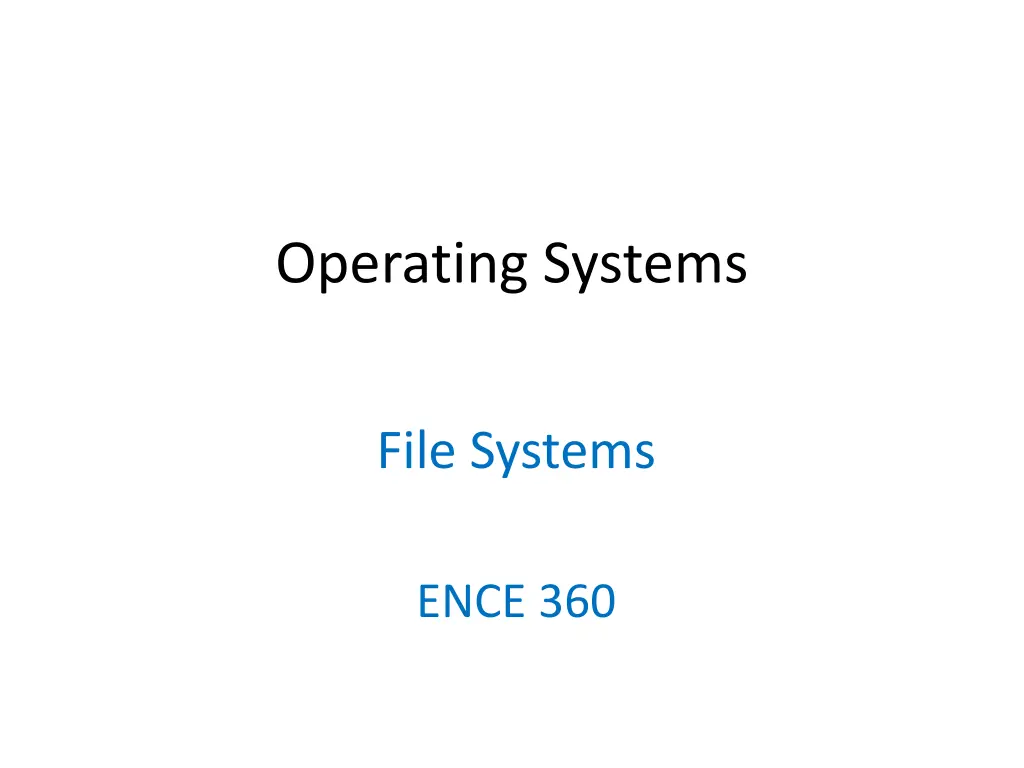
Implementing File Systems in Operating Systems
Explore the motivation, requirements, and solutions behind implementing file systems in operating systems, including top-down and bottom-up approaches. Learn about the core concepts of file system implementation, Unix file handling, system components, and various allocation strategies such as contiguous and linked-list allocation.
Download Presentation

Please find below an Image/Link to download the presentation.
The content on the website is provided AS IS for your information and personal use only. It may not be sold, licensed, or shared on other websites without obtaining consent from the author. If you encounter any issues during the download, it is possible that the publisher has removed the file from their server.
You are allowed to download the files provided on this website for personal or commercial use, subject to the condition that they are used lawfully. All files are the property of their respective owners.
The content on the website is provided AS IS for your information and personal use only. It may not be sold, licensed, or shared on other websites without obtaining consent from the author.
E N D
Presentation Transcript
Operating Systems File Systems ENCE 360
Motivation Top Down: Process Need Processes store, retrieve information When process terminates, memory lost How to make it persist? What if multiple processes want to share? Requirements: large persistent concurrent access Solution? Hard disks are large, persistent!
Motivation Bottom Up: Hard Disks Disks come formatted with blocks (typically 512 bytes) bs boot sector sb super block Requirements Differentiation of data blocks Reading and writing of blocks Efficient access CRUX: HOW TO IMPLEMENT A FILE SYSTEM ON A HARD DISK How to find information? How to map blocks to files of all sizes? How to know which blocks are free? Solution? File Systems
Outline Introduction Implementation Directories Journaling (done) (next) Chapter 39, 40 Chapter 4 MODERN OPERATING SYSTEMS (MOS) By Andrew Tanenbaum OPERATING SYSTEMS: THREE EASY PIECES By Arpaci-Dusseau and Arpaci-Dusseau
Example: Unix open() int open(char *path, int flags [, int mode]) path is name of file (NULL terminated string) flags is bitmap to set switch O_RDONLY, O_WRONLY, O_TRUNC O_CREATE then use mode for permissions success returns index On error, -1 and set errno
Unix open() Under the Hood int fid = open( blah , flags); read(fid, ); User Space System Space Disk Process Control Block File sys info File Descriptor Table Copy fd to mem stdin stdout stderr 0 1 2 3 Open File Table File descriptors ... Directories File File Structure (index) ... Descriptor ... Data (File attributes) (Where blocks are) (Per process) (Per device)
File System Implementation Core data to track: which blocks with which file? Job of the file descriptor Different implementations: a) Contiguous allocation b) Linked list allocation c) Linked list allocation with index d) Inode File Descriptor
Contiguous Allocation (1 of 2) Store file as contiguous blocks on disk Good: Easy: file descriptor knows file location in 1 number (start block) Efficient: read entire file in 1 operation (start & length) Bad: Static: need to know file size at creation Or tough to grow! Fragmentation: chunks of disk free but can t be used (Example next slide)
Contiguous Allocation (2 of 2) Delete Delete What if want new file, size 8 blocks? Fragmentation ( free but can t be used)
Linked List Allocation Keep linked list with disk blocks null null File Block 0 File Block 1 File Block 2 File Block 0 File Block 1 Physical Block 4 7 2 6 3 Good: Easy: remember 1 number (location) Efficient: no space lost in fragmentation Bad: Slow: random access bad (e.g., process want s middle block)
Linked List Allocation with Index Physical Block Table in memory MS-DOS FAT, Win98 VFAT Good: faster random access Bad: can be large! e.g., 1 TB disk, 1 KB blocks Table needs 1 billion entries Each entry 3 bytes (say 4 typical) 4 GB memory! File Allocation Table 0 1 2 null 3 null 4 7 5 6 3 7 2 Common format still (e.g., USB drives) since supported by many OSes & additional features not needed
inode Fast for small files Can hold large files Typically 15 pointers 12 to direct blocks 1 single indirect 1 doubly indirect 1 triply indirect Number of pointers per block? Depends on block size and pointer size e.g., 1k byte block, 4 byte pointer each indirect has 256 pointers Max size of file? Same depends on block size and pointer size e.g., 4KB block, 4 byte pointer max size 2 TB
Linux File System: ext3 inode // linux/include/linux/ext3_fs.h #define EXT3_NDIR_BLOCKS 12 // Direct blocks #define EXT3_IND_BLOCK EXT3_NDIR_BLOCKS + 1 // Indirect block index #define EXT3_DIND_BLOCK EXT3_IND_BLOCK + 1 // Double-ind. block index #define EXT3_TIND_BLOCK EXT3_DIND_BLOCK + 1 // Triple-ind. block index #define EXT3_N_BLOCKS EXT3_TIND_BLOCK + 1 // (Last index & total) struct ext3_inode { __u16 i_mode; // File mode __u16 i_uid; // Low 16 bits of owner Uid __u32 i_size; // Size in bytes __u32 i_atime; // Access time __u32 i_ctime; // Creation time __u32 i_mtime; // Modification time __u32 i_dtime; // Deletion time __u16 i_gid; // Low 16 bits of group Id __u16 i_links_count; // Links count __u32 i_blocks; // Blocks count ... __u32 i_block[EXT3_N_BLOCKS]; // Block pointers ... }
Outline Introduction Implementation Directories Journaling (done) (done) (next)
Directory Implementation Just like files ( wait, what? ) Have data blocks File descriptor to map which blocks to directory But have special bit set so user process cannot modify contents Data in directory is information / links to files Modify only through system call (right) Tree structure, directory most common Directory System Calls Create Delete Opendir Closedir Readdir Rename Link Unlink See: ls.c
Directories Before reading file, must be opened Directory entry provides information to get blocks Disk location (blocks, address) Map ASCII name to file descriptor name block count block numbers Where are file attributes (e.g., owner, permissions) stored?
Options for Storing Attributes a) Directory entry has attributes (Windows) b) Directory entry refers to file descriptor (e.g., inode), and descriptor has attributes (Linux)
Windows (FAT) Directory Hierarchical directories Entry: name type (extension) time - date - block number (w/FAT) name type attrib time date block size
Unix Directory Hierarchical directories Entry: name inode number (try ls i or ls iad . ) Example, say want to read data from below file /usr/bob/mbox Want contents of file, which is in blocks Need file descriptor (inode) to get blocks How to find the file descriptor (inode)? inode name
User Access to Same File in More than One Directory C B (Instead of tree, really have directed acyclic graph) B C A ? alias Possibilities for alias : A. Refer to file descriptor in two locations hard link B. Special directory entry points to real directory entry soft link Examples: try ln , ln -s and ls -i Windows shortcut but only viewable by graphic browser, absolute paths, with metadata, can track even if move
Keeping Track of Free Blocks Keep one large file of free blocks (use normal file descriptor) Contents are bitmap of free blocks (preserves locality, but 1-bit/block) Contents are linked-list of free blocks (can be small when full, but no locality)
Outline Introduction Implementation Directories Journaling (done) (done) (done) (next)
Need for Robust File Systems Consider upkeep for removing file 1. Remove file from directory entry 2. Return all disk blocks to pool of free disk blocks 3. Release file descriptor (e.g., inode) to pool of free descriptors What if system crashes in middle? a) inode becomes orphaned (lost+found, 1 per partition) b) Same blocks free and allocated If flip steps, blocks/descriptor free but directory entry exists! Crash consistency problem inode 5 91 12 3 1 91 2
Crash Consistency Problem Disk guarantees that single sector writes are atomic But no way to make multi-sector writes atomic How to ensure consistency after crash? 1. Don t bother to ensure consistency Accept that the file system may be inconsistent after crash Run program that fixes file system during bootup File system checker (e.g., fsck) 2. Use transaction log to make multi-writes atomic Log stores history of all writes to disk After crash log replayed to finish updates Journaling file system 24
File System Checker the Good and the Bad Advantages of File System Checker Doesn t require file system to do any work to ensure consistency Makes file system implementation simpler Disadvantages of File System Checker Complicated to implement fsck program Many possible inconsistencies that must be identified Many difficult corner cases to consider and handle Usuallysuper sloooooooow Scans entire file system multiple times Consider really large disks, like 400 TB RAID array! 25
Journaling File Systems 1. Write intent to do actions (a-c) to log (aka journal ) before starting Option - read back to verify integrity before continue 2. Perform operations 3. Erase log Block Group 0 Block Group 1 Block Group N Superblock Journal If system crashes, when restart read log and apply operations Logged operations must be idempotent (can be repeated without harm)
Journaling Example Assume appending new data block (D2) to file 3 writes: inode v2, data bitmap v2, data D2 Before executing writes, first log them Journal TxB ID=1 TxE ID=1 I v2 B v2 D2 1. TxB: Begin new transaction with unique ID=1 2. Write updated meta-data block (inode, data bitmap) 3. Write file data block 4. TxE: Write end-of-transaction with ID=1 27
Commits and Checkpoints Transaction committed after all writes to log complete After transaction is completed, OS checkpoints update Committed! Journal TxB I v2 B v2 D2 TxE Inode Bitmap Data Bitmap Checkpointed! Inodes Data Blocks v1 v2 D1 D2 Final step: free checkpointed transaction 28
Crash Recovery (1 of 2) What if system crashes during logging? If transaction not committed, data lost But, file system remains consistent! Journal TxB I v2 B v2 D2 Inode Bitmap Data Bitmap Inodes Data Blocks v1 D1 29
Crash Recovery (2 of 2) What if system crashes during checkpoint? File system may be inconsistent During reboot, transactions committed but not completed are replayed in order Thus, no data is lost and consistency restored! Journal TxB I v2 B v2 D2 TxE Inode Bitmap Data Bitmap Inodes Data Blocks v1 v2 D1 D2 30
Journaling Summary Advantages of journaling Robust, fast file system recovery No need to scan entire journal or file system Relatively straight forward to implement Disadvantages of journaling Write traffic to disk doubled Especially file data, which is probably large Can fix! Only journal meta- data! (Left for student exploration) Today, most OSes use journaling file systems ext3/ext4 on Linux NTFS on Windows Provides crash recovery with relatively low space and performance overhead Next-gen OSes likely move to file systems with copy- on-write semantics btrfs and zfs on Linux 31
Outline Introduction Implementation Directories Journaling (done) (done) (done) (done)

